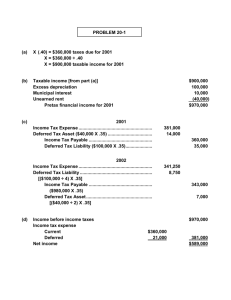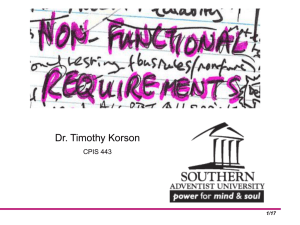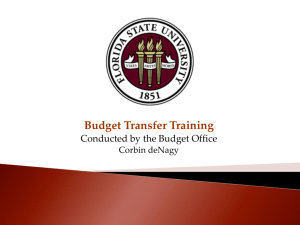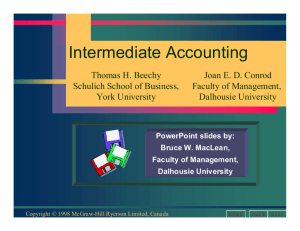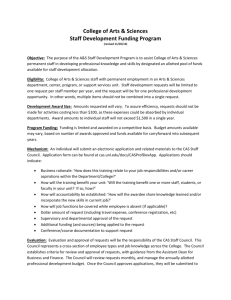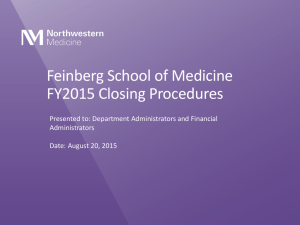Carryforward?
advertisement
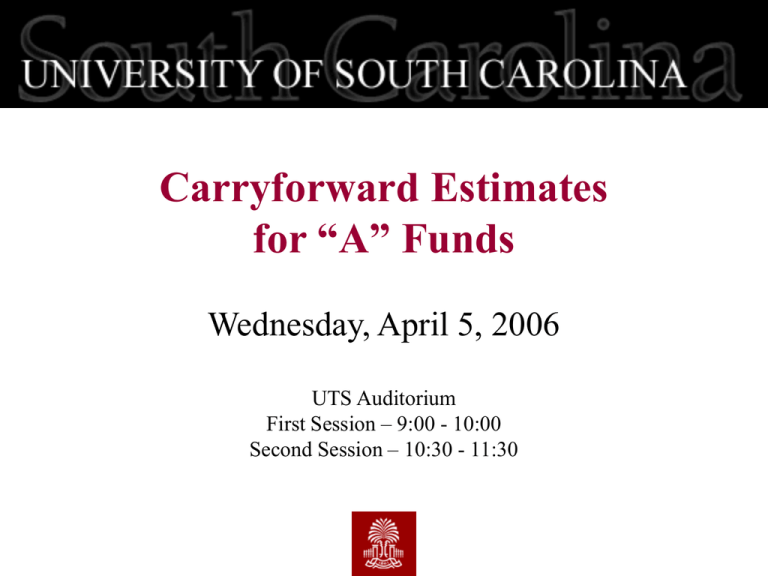
Carryforward Estimates for “A” Funds Wednesday, April 5, 2006 UTS Auditorium First Session – 9:00 - 10:00 Second Session – 10:30 - 11:30 What is Carryforward? Surplus funds that are retained by the unit at the end of the fiscal year and included in the following year’s budget How Does a Unit Generate Carryforward? Surplus funds are generated when the SOURCES for a unit exceed the USES during the fiscal year Carryforward = MONEY Carryforward is analogous to retained earnings in corporate income statements Retained earnings are money available for use So why have money? Transactions demand Precautionary demand Speculative demand What is My Unit’s Carryforward? Object codes 31533 & 31534 How Do I Calculate My Carryforward? 1. Start with the prior year’s carryforward amount (31533 & 31534) 2. Add final BUDGETS for remaining allocations (3’s) 3. Add ACTUAL revenues (4’s) 4. Add ACTUAL transfers from (81XXX) 5. Subtract ACTUAL transfers to (86XXX) 6. Subtract ACTUAL expenditures (5’s) 7. Add ACTUAL IITs (6’s) 8. Balance = New year’s carryforward amount The balance should equal the YTD fund balance PLUS the allocation budgets (All the 3’s) What Are My Unit’s Sources? Tuition & Fees (Academic Units) 401XX Other Revenue 4XXXX State Appropriations 31500/31525/31526 NET of other 3’s Non-recurring - 363XX/368XX and 36400/36500 Permanent - 373XX/378XX and 37400/37500 NET of Transfers 81XXX and 86XXX Tax In and Tax Out 81150/81160 and 86150/86160 Carryforward 31533/31534 What Are My Unit’s Uses? Expenditures 5XXXX Contra-Expenditures 6XXXX How Does Carryforward Occur? SOURCES exceed USES Examples: Tuition and fee receipts are higher than budget Transfers in more than anticipated Expenditures are lower than budget Salary lag IIT’s are higher than expected Planned project/initiative is implemented late Expenditures move to grant funds The reverse is true too – if USES exceed SOURCES, then a unit would have a NEGATIVE carryforward Is Carryforward Recurring or Non-recurring? This is the million dollar question! By definition – carryforward is non-recurring! – if your unit’s regular actual expenditures are less than regular actual revenues – there is a recurring component to your carryforward BUT Under the DECENTRALIZED budget method we operate under, the Budget Office cannot tell you what your recurring carryforward is – the unit’s have to determine this given the many differences under which they operate What About the Other Funds? Do the other alphabet funds have carryforward? Yes – it is the fund balance – booked by an OB to object 32000 Current Funds: B, C, D, E, R and S (some) – unrestricted F, G, H, J, K, L and S (most) – restricted Non-Current Funds: Loan, Endowment, Agency, Plant What About the Other Campuses? Do the USC Senior, Regional and School of Medicine campuses have “A” fund carryforward? Yes – it is the campus fund balance All campuses except for one have “A” fund balance less than 10% of their “A” fund budget Is Carryforward Bad? NO! Having carryforward allows us to plan expenditures end-of-year spending under a “use-it-orlose it” mentality Discourages BUT – too much carryforward MIGHT be bad Why Would “Too Much” Carryforward Be Bad? Perception – Tuition caps, reduced state allocation, reduced philanthropy Public Management Problem – Understating revenue, overstating expenditures Financial Misalignment Inability dollars of resources to needs to express commitments on carryforward What is “Too much” Carryforward? There is not one answer for that because it is specific to each unit with carryforward Every Every unit operates differently unit has a different level of budget and mix of funds So Why Are We Completing a Carryforward Estimate? Carryforward is a component of the University budget and is reported to the Board of Trustees in total during the budget development process Estimating carryforward is one step towards better budget forecasting for the next year and in future years Units at USC need to manage carryforward What is Carryforward Management? At the unit level, the administration is looking for clearly defined and expected commitments of these funds Better budget planning on the front end yields less variance which yields less unforecasted changes in carryforward balances What is Carolina’s “A” Fund Carryforward Position? The percentage of carryforward to total “A” fund budget at January 31, 2006 USC Columbia – TOTAL – 11.59% Academic Units – 12.68% Service Units – 11.11% Of the total amount of “A” fund carryforward Academic Units have 61% of the total Service Units have 39% of the total How Well Did Units Estimate Carryforward Last Year? The difference in the unit projections and actual carryforward was just over $15M - a swing of over 32% Why Were the Estimates Off Last Year? The source of carryforward not well understood The estimate was a new request – units unsure of its purpose and use Are units deliberately understating revenue and overstating expenditures? How Do We Make Our Estimates Better? Carryforward Template What Do I Need to Complete This Template? General Ledger as of March 31, 2006 General Ledger as of March 31, 2005 FY2004/2005 General Ledger FINAL Academic Units – Tuition report for Spring 2006 and Summer I 2005 Fall/Spring review Discussion with dean and/or department head What Are Some Things to Consider? Do I have one-time expenditures before June 30? Are there any year-end specific transfers that effect my unit? Does any unit owe me revenue or transfers (3’s or 8’s) or do I need to complete any IIT’s? Do I need to transfer funds to a “W” account? For academic units, there will be an assessment of utility costs prior to June 30 to cover the utilities shortfall Are there current commitments that will not be liquidated by June 30 that will be expended in the next year Is Summer I expected to have the same enrollment as last year? What is the Impact of Summer I? Unlike the academic year, the fiscal year encompasses the student terms beginning with Summer II, then Fall, then Spring, Maymester, and ends with Summer I Summer School revenue is booked just prior to the close of the fiscal year, however, because this happens every year, it is a rolling process – the unit will always have five semesters worth of tuition each year The The budget is there from the beginning of the year adjustments from budget to actual for the summer terms are minor as the tuition receipts tend to follow the prior year collections, but include the tuition increase from the prior year What is the Impact of Summer I? The booking of Summer I revenue and the payment of Summer I expenditures by June 30 adheres to the accounting principle of matching revenues to expenditures in the same period The majority of expenditures associated with Summer I are expended by June 30 and during the post-close process If payroll documents are submitted as requested, June 30 is the final pay date for faculty for Summer I Carryforward is not calculated until after the fourth post-close of the accounting system to be sure that entries from the prior year are captured What is the Impact of Summer I? Summer I is treated now like all the academic terms in that under the budget methodology the net E&G revenue is allocated to the department Prior to the implementation of VCM, academic units received all their Summer revenues – but did not receive Fall and Spring which went to the general fund should not be thought of as being different – in fact the treatment of the other terms changed to be more like Summer was previously handled Summer Carryforward Calendar – FY2007 Budget Development March Carryforward removed from base line-item budget for all units April All units estimate carryforward Mid-April Carryforward estimate rolled up for senior administration May Vice President’s budget hearings with President June Carryforward estimate rolled up in Board of Trustees Budget Document July As weekly post-close runs, carryforward estimate updated by Budget Office Early August Carryforward workbooks sent to all units Mid-August Carryforward BD’s due to Budget Office So What Happens After This? After FY2007 budget is approved and loaded, the Budget Office will complete a FY2006 variance analysis for each unit using the Fall and Spring Review template Budget Office will develop training sessions for Business Managers to complete a three year budget projection Three year projection is intended to tie to strategic planning – the Blueprint for Excellence CFO, Provost, and VPRHS will review QUESTIONS

